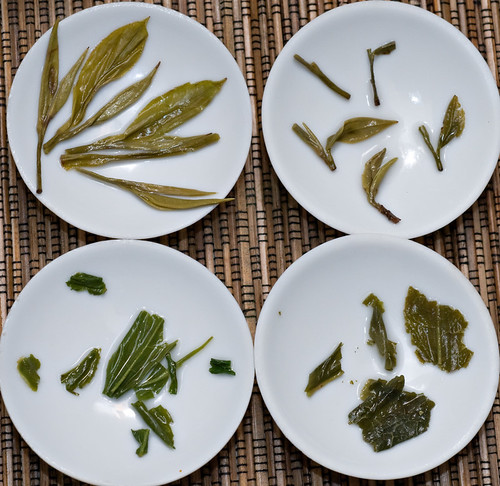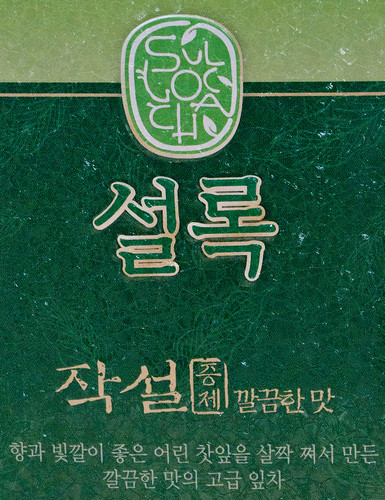Jade Pole Supreme Yunnan green tea from Yunnan Sourcing
Yunnan Bao Hong spring 2009 early green tea from Yunnan Sourcing
Jaksul green tea from Hankook
Jeung Je ‘not fermented’ green tea (label says http://www.sulloc.co.kr and nothing else in English)
Used 1.8 grams of tea in small 40 mL gaiwans
Infusions 160°F/71°C-170°F/77°C
30”, 30” (probably too long, with all the bitterness coming out), 30”
Jade Pole Supreme Yunnan green tea from Yunnan Sourcing
Dry Leaves: long twists of intact leaves, camphor, vegetal, grassy aroma
Liquor, 1st infusion: pale ivory liquor; mild, camphor, floral
Liquor, 2nd infusion: peachy, sweet, camphor
Liquor, 3rd infusion: peachy, sweet, camphor, first astringency, hints of bitterness
Wet Leaves: beautifully intact yellow-green leaves, in pairs of one very small bud and one larger leaf
Yunnan Bao Hong spring 2009 early green tea from Yunnan Sourcing
Dry Leaves: flat thin small leaves and fragments, some stems, scent of hay, grass
Liquor, 1st infusion: yellow liquor; thicker body; hay, warm, less camphor, but very similar to the Jade Pole
Liquor, 2nd infusion: nutty, dark, vegetal, astringent
Liquor, 3rd infusion: sweet, vegetal, bit nutty, but much less astringent
Wet Leaves: more broken pieces, leaves are quite small, yellow-green,and also mostly buds and small leaves
Jaksul green tea from Hankook
Dry Leaves: curled small leaves and fragments, sweet, woodsy, piney
Liquor, 1st infusion: green clear liquor; grassy, a little sweet
Liquor, 2nd infusion: more astringent, even bitter, still grassy
Liquor, 3rd infusion: nutty, vegetal, mildly astringent
Wet Leaves: larger, broken leaves, fairly flat, very deep green
Jeung Je ‘not fermented’ green tea (label says http://www.sulloc.co.kr and nothing else in English)
Dry Leaves: very thin flat leaves, deepest green, sweet grass scent
Liquor, 1st infusion: green clear liquor; grassy, sweet, vegetal
Liquor, 2nd infusion: liquor very bright deep yellow; astringent, grassy, some bitterness
Liquor, 3rd infusion: astringency, grassy, vegetal
Wet Leaves: broken leaves, very curly even now, hard to flatten, darker green than the first two but less than the Jaksul
Photos:
Upper left Jade Pole Supreme Yunnan green tea from Yunnan Sourcing
Upper right Yunnan Bao Hong spring 2009 early green tea from Yunnan Sourcing
Lower left Jaksul green tea from Hankook
Lower right Jeung Je ‘not fermented’ green tea (label says http://www.sulloc.co.kr and nothing else in English)








